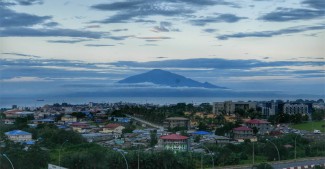International Monetary Fund (IMF) economists Martin Kaufman and Papa N’Diaye discuss the impacts of the current trade tensions, and the prospects for developing economies in an unsteady global landscape.
Trade, as we know, is a hot topic. But less has been said about how the current trade tensions are impacting developing countries. What about those economies?
Martin Kaufman, Assistant Director, Strategy, Policy and Review Department: A strong global economy has been critical for emerging markets and developing economies. If they are to grow and to develop, they need a vibrant global economic environment – that for us is very, very clear.
Unfortunately, the latest World Economic Outlook (WEO) sees global growth – not only this year and next year but in general going forward for the next few years – very subdued. That creates really challenging conditions for emerging markets and developing economies.[1] An important headwind to the outlook in the WEO is the current US-China trade tensions, but also it is important to recognize that a slowdown in China may affect some emerging markets and developing economies differently. So it’s not just global growth, but for countries closely linked with China it’s also what’s happening there. Those are some of the big issues highlighted.
As to what emerging markets and developing economies can do at the current juncture, some recommendations are very close to what we recommend to countries in general, but they may be more pressing now. One is financial resilience – ensuring that policy actions are taken to avoid crises that will create broader economic and social problems. Plus, crises are especially bad for the poorer segments of any society. This is a bit of our mantra but I think it remains a very important point to underscore.
We recognize that many emerging markets and developing economies may have less room to use fiscal policy to ensure that growth doesn’t suffer too much. Fiscal space may be limited because of relatively high debt or even when debt is not too high, access to financing may be limited. It is thus very important to use the limited room for fiscal policy wisely in trying to sustain economic growth.
It is also very important in general, but particularly in these circumstances, to strengthen institutions in terms of governance and policy frameworks. These are reforms that countries should be doing anyway and can make a difference, including by providing investors greater comfort and allowing country authorities more room for manoeuvre to navigate the headwinds that many countries are facing from the global environment.
The latest World Economic Outlook (WEO) sees global growth – not only this year and next year but in general going forward for the next few years – very subdued. That creates really challenging conditions for emerging markets and developing economies.
Martin Kaufman, Assistant Director, Strategy, Policy and Review Department, IMF
Papa N’Diaye, Division Chief, Regional Studies Division, African Department: With the elevated uncertainty related to trade tensions, what we are seeing is that these economies are not immune – they are being impacted. Export volumes have declined quite a lot since the trade tensions began. And this is just one indication of the impact of the trade tensions on these economies. Plus, what we see in terms of the outlook is that most of the countries are now facing slower growth than what we anticipated six months ago. The country teams have revised down for two-thirds of the countries the growth forecast for 2019-2020.
On top of that you have the demographic pressure, the need to create jobs for all the new entrants to the labour markets. Over the past five years, for example, we estimate the African continent created 10 million jobs annually. To absorb all the new entrants into the labour market through 2030 they will need to double that amount. We are talking about moving from creating 10 million jobs on a net basis to 20 million jobs and if you do it in an environment that is less conducive then you can see the challenge that these countries face.
What are low-income and developing countries in Africa experiencing, and what can they do to weather this storm?
PN: In this difficult environment, countries in the region have very limited room for policy manoeuvres, and our advice is for these countries to reduce their debt vulnerabilities, try to advance diversification, try to raise their medium-term growth prospects and strengthen their resilience to shocks to commodity prices, which is essentially the main channel through which they are being impacted.
When you look at the growth pattern across the region you could group them in two camps. There are the fast-growing countries that are the more diversified, the non-resource intensive countries where you can find growth rates that average 6% like Senegal, Cote D’Ivoire, Rwanda, Uganda and so on.
The other group is the resource-intensive countries that includes the oil exporters and metal-dependent countries that are still struggling to try and adjust from the commodity shocks of 2014. Those countries are growing on average around 2 to 2.5% and these are very low growth rates given the demographic pressures in many of these countries, such that in per capita terms these growth rates translate into negative income growth.
Over the past five years, for example, we estimate the African continent created 10 million jobs annually. To absorb all the new entrants into the labour market through 2030 they will need to double that amount.
Papa N’Diaye, Division Chief, Regional Studies Division, African Department, IMF
You have countries with a population of 100 million plus like Nigeria that essentially is expected to experience a decline in per capita income in the next few years. These economies rely heavily on one commodity, so it would be critical for them to advance diversification over the medium term and mobilize more revenue to be able to invest in physical and human capital.
The bad news is that even though we can celebrate that we have 24 countries growing at 6% and you can see about 500 million people living in those countries who are going to benefit and see their income increase at a faster pace, we have 21 large oil and resource-intensive countries that are home to about 700 million people that will see slower income growth.
You mentioned earlier that countries trading with China could be impacted differently by the trade tensions and global slowdown. Can you explain?
MK: It is important to distinguish that the impact will depend on the type of trade and channels involved. Countries that have strong links through supply chains will experience a different impact than those that primarily export commodities. Structural transformation would affect both but in different ways in the short and medium term.
In terms of supply chains in particular, before the trade tensions China’s supply chains were changing – including moving up the value-added ladder. This implied that many tasks, for instance assembly ones, were being moved to other countries which in turn became integrated into such supply chains. This is a sort of “crowding in” effect. So a slowdown in China would have greater implications for countries that are now more integrated into supply chains based there. But it is also important to recognize that going forward because of uncertainty there may be some reconfiguration of supply chains.
--------
[1] This interview was conducted before phase 1 of the US-China trade deal was signed on 15 January 2020.
------
This is the first of a two-part series. Part II can be found here.
Header image of a health extension worker in Addis Ababa, Ethiopia - ©NahomTesfaye/UNICEFEthiopia via Flickr Creative Commons Attribution-NonCommercial-NoDerivs 2.0 Generic (CC BY-NC-ND 2.0) license.
If you would like to reuse any material published here, please let us know by sending an email to EIF Communications: eifcommunications@wto.org.



